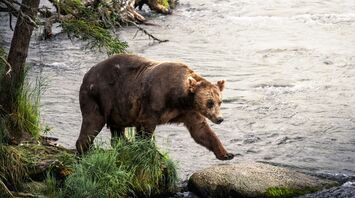Everything to Know About Katmai National Park

Katmai National Park, located on the Alaska Peninsula, is a haven for hiking, fishing, bear-watching, and exploring volcanoes. This park is renowned for its 14 active volcanoes and the largest protected population of brown bears in North America, with approximately 2,000 bears roaming the area.
Visitors to Katmai can engage in various activities such as hiking, kayaking, and canoeing. The park's rivers, as clear as glass, offer excellent fishing opportunities, where anglers can observe brown bears catching salmon. Katmai's extreme volcanic activity adds to its allure, with the 1912 eruption of Novarupta being the largest volcanic event of the 20th century.
Botanist Robert F. Griggs led a National Geographic Society expedition in 1916, discovering the Valley of Ten Thousand Smokes, named for the numerous fumaroles steaming from the valley floor. This discovery played a crucial role in Katmai's inclusion in the National Park System.
Best Views in the Park
For panoramic views of Katmai, Dumpling Mountain is an excellent choice. Located 4.6 miles northwest of Brooks Camp, the summit offers vistas of Naknek Lake and the distant Alaska Range. Experienced wilderness enthusiasts can paddle across Naknek Lake and bushwhack up Mount Katolinat for even more stunning park views.
Best Trails
The Brooks Falls Trail, a 1.2-mile wheelchair-accessible hike, leads to bear-viewing platforms along the Brooks River. Other short, easy trails from Brooks Camp include the Cultural Site Trail, which explores archaeological sites, and the Brooks River Bridge Trail, offering views of Naknek Lake.
Energetic hikers can tackle the 23-mile Valley of Ten Thousand Smokes Road, leading to the Robert F. Griggs Visitor Center and the valley’s volcanic wonders. Brooks Lodge provides a shuttle service to the visitors center.
Wildlife Viewing
Brooks Falls is world-renowned for bear viewing, particularly during the summer salmon run. The park also offers bear watching in mudflats, meadows, and salmon streams along the Pacific coast from June to September. Other wildlife includes river otters, porcupines, eagles, and marine creatures like sea lions, sea otters, humpback whales, and orcas.
Activities and Excursions
Bear watching is the park’s premier attraction, with several platforms along the Brooks River. For day trips, aviation outfits like Katmai Air and Rust’s Flying Service offer bear-viewing flights from Anchorage. Brooks Camp also rents fishing gear, canoes, and kayaks, and offers guided tours to the Valley of Ten Thousand Smokes.
Katmai is ideal for experienced backpackers and paddlers. The 80-mile Savonoski Loop is an epic paddling trail starting and ending at Brooks Camp. Backcountry camping is allowed beyond a 1.5-mile radius around Brooks Camp, with mandatory bear-proof food storage.
Family-Friendly Activities
While not ideal for younger children, older kids and teens will enjoy wildlife watching, short hikes, fishing, and canoeing at Brooks Camp. The park also offers a Junior Ranger Program and ranger-led excursions to the Valley of Ten Thousand Smokes.
Where to Stay
The National Park Service operates Brooks Camp Campground and Fure’s Cabin, with reservations available at Recreation.gov. Privately run accommodations include Brooks Lodge, Katmai Wilderness Lodge, and several remote fishing lodges.
Essential Information
Katmai is accessible by air, with Alaska Airlines flights from Anchorage to King Salmon, followed by floatplane service to Brooks Camp. Alternatively, the Katmai Water Taxi operates from King Salmon to Brooks Camp during the summer. The best time to visit is June to September, with bear watching peaking in July.



















